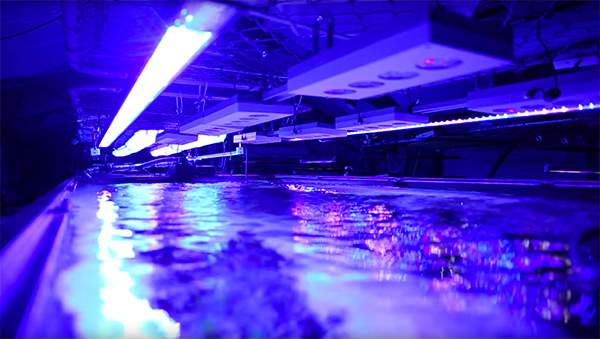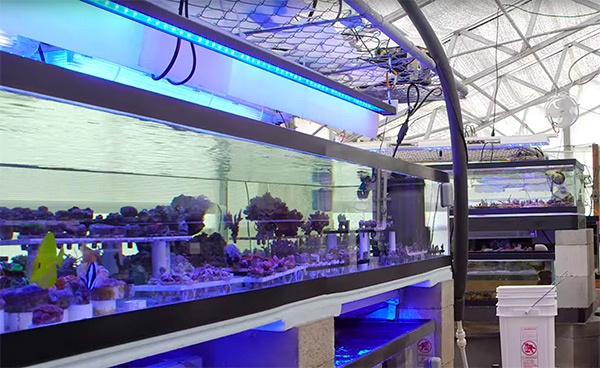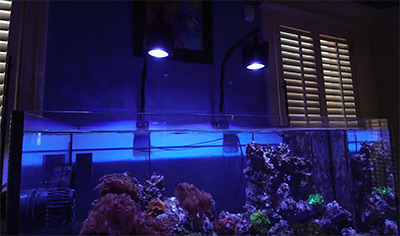I get asked fairly often what light is the best light. Unfortunately, there is no right answer. First off, there is the difference in aesthetics. That is a purely subjective decision that only hobbyists can make for themselves. Most of the time hobbyists gravitate towards the blue end of the spectrum because it is very flattering to corals that fluoresce brightly.
In terms of coral biology, the type of lighting that will work the best for your tank will depend a great deal on what animals you intend to keep. As I mentioned in Part 1, corals will adapt to lighting by regulating their zooxanthellae, so most coral will grow under any of these lighting technologies. Having said that, it is also entirely possible to have some corals take on a desirable appearance while other corals become less attractive under the same light. Such is the price to be paid for a mixed reef tank. It is often not possible to optimize a light for every coral inhabitant when they come from completely different geographies and natural conditions.
As far as the type of technology to use, that will depend on what aspects of the technology are most important to you. There are also pros and cons to any type of lighting technology, whether it is LED, T5, metal halide, or even natural sunlight. Depending on your situation, the drawbacks of one technology might not matter to you. Conversely, the benefits of another technology might not be meaningful to you.
Let’s talk for a bit about each one in turn, starting with the most popular:
Light-emitting diodes (LEDs)
LED fixtures are nice because they offer the most in terms of control. It is possible to control each LED individually, so the hobbyist can customize the schedule, colors, and intensity. Of all the types of lighting, I think LEDs do the best job of showcasing corals by bringing out the most appealing fluorescence. They are energy-efficient, and the LEDs themselves are long-lasting. Lastly, the fixtures tend to run cooler than T5 fluorescents or metal halides, which is a big deal for hobbyists in warmer climates that have to battle to cool their tanks. It is far more difficult to cool water down than it is to heat it up.
The downside to LEDs is that some corals do not color up as well under LED as they would under other types of light, in particular SPS and certain LPS such as Acanthastrea and Micromussa. I use a lot of LED in my greenhouse currently, mainly to conserve energy, but I prefer both T5 and metal halide when it comes to growth and developing color. Some aquarists have issues with the spotlight nature of LEDs, where dark shadow areas on the undersides of corals cause the colony to die off.
Also, while the LEDs themselves last a long time, the longevity of the fixture can be substantially shorter than the rated life of the LED because other electronic components fail. The last downside to LED is not going to affect too many people, but for those interested in photography, LED is the worst light ever invented.
For better or worse, LED is quickly becoming the most popular form of lighting in the hobby, if it’s not already. Compared to the other types, it is the newest technology and could see some major improvements down the line that eliminate many of the drawbacks I listed.
T5 fluorescent
T5 fluorescent bulbs are thin glass tubes that produce a very robust light spectrum that colors up corals nicely. Almost every insanely colored SPS aquarium that simply blew me away implemented this type of lighting.
There are a lot of bulb choices available that can give your tank pretty much any type of aesthetic. I say “pretty much” because the neon disco look that an all-blue LED light gives is pretty unique. While they are not controllable to the extent LEDs are, there are some fixtures out there that can dim T5 bulbs to give that dawn/dusk lighting effect (though I don’t know if that reduces the life of the bulbs). Lastly, because the light emitted by a T5 bulb is spread out evenly over the length of the bulb, there is almost no trace of shadowing effects that plague point-source lighting.

No lighting system is perfect, however, and T5 fixtures have their drawbacks. First off, the bulb life is frustratingly short. They begin to erode both in terms of spectrum and intensity right around 6 months, and by 12 months, they are a drastically different bulb. Here at the greenhouse, I run them a lot longer than that, just because they are supplementing the sunlight we receive, but when I do finally get around to swapping out the bulbs, the difference is staggering. The second downside is the energy efficiency, which, while not horrible on a per-bulb basis, is not as good as that of the LED lights.
Depending on the number of bulbs in the fixture, T5s can get expensive to operate. For example, if you have an 8-bulb fixture, the electrical consumption along with the cost of bulb replacements might make for the most expensive lighting upkeep out of all the technologies. Lastly, the bulbs themselves are fragile and can easily break during shipping, especially when you consider the longer bulb lengths of 48” and 60”.
Metal halide lighting
Finally we get to metal halide, which I would venture to guess is the least popular form of lighting at the hobbyist level and likely the most popular lighting at the commercial level. The positive aspects of metal halides are their intensity, spectrum, and longevity. When it comes to growing light-loving corals, I don’t think any other technology does it as well.
Metal halide bulbs are a point light source like LEDs but are even more concentrated. When shining down into the tank, they create a very pleasing shimmering effect, which is almost absent under the diffuse light of a T5 fluorescent bulb. Those shimmer lines closely replicate what is seen in nature, and a study done several years back indicated that corals actually benefit from them.
The major problems with metal halides are energy consumption and heat. Metal halide bulbs consume a ton of electricity, and it will be noticeable on your monthly electric bill if you just installed a new halide fixture. The heat generated by metal halides is also something that has to be dealt with. In large aquariums situated in a large room, some well-placed cooling fans might do the trick. On smaller aquariums or in tight quarters where heat builds up, one might need to install a chiller or crank up the air conditioning to compensate. Either way, heat management will further increase the electricity bill.
In terms of controllability, it is practically absent from these bulbs. They can turn on and off. In some ways, they don’t even do that well all the time because some require a cooling off period before they can turn back on. There are dimmable metal halides, but from everything I’ve read, it’s not great for the bulbs and some bulbs will shift colors as a result.
Now that we have gone over the types of lighting, hopefully you can see that all of them have their pros and cons. What will make for the best light in your tank will depend in large part on the factors that are important to you. I can say upfront that most corals can be kept under just about any kind of light fixture. The list of corals that demand extremely intense light is surprisingly short, but who am I kidding, we aquarists are trying to squeeze out that last 1% of color from our corals.
Hybrid lighting solutions
Picking what light to go with can be daunting, but the obvious solution to deciding on a fixture is to not really decide on anything. You could get a light that incorporates more than one technology. Hybrid lighting systems exist that combine LED and T5, metal halide and T5, or metal halide and LED. There might even be some systems out there that combine all three.
That fixture might be shockingly expensive, so here is a cost-saving tip: Let’s say you have an LED fixture you are happy with but want to supplement it with T5, but you don’t like the look of the T5 bulbs. What you could do is purchase an inexpensive T5 fixture with all white bulbs and only run it for about 4 to 6 hours while you are away from the tank. That way, the corals still benefit from the light and color up nicely but it won’t interfere with the aesthetic of the LEDs when you return home.
Natural light

Tidal Gardens uses a mix of natural light from a greenhouse structure and supplemental light from mainly T5 and LED fixtures. When the greenhouse was constructed back in 2002, the idea was that the sun is the perfect light on the perfect timer and corals grown under this light would be the healthiest specimens for the lowest electrical cost.
This premise still might be true, but not necessarily here in Ohio where the greenhouse is located. The difference in lighting from season to season has a drastic affect on the corals, and some species don’t like it at all. One might guess that it is the cold, dark Ohio winters that are the problem, but it is actually the summers. The winter months, it turns out, are some of the best for growing just about every coral. If I had to guess, it has to do with both the change in light intensity as well as the photoperiod. In the summer, it feels like the sun is in the sky twice as long, and that is not a good thing. The shorter photoperiod of the winter months has proven to be a much better situation for the corals here.
Setups that are designed to use natural light would be the most successful in areas that have the most consistent climates, but preferably not in crazy-hot climates because it is far more difficult to chill water than it is to heat it up.
Conclusion
Light is a vitally important aspect of the hobby and a heavily debated topic among reef aquarists. Hopefully this article helps you decide which type of lighting you want for your system. Let us know which you ended up choosing in the comment section below.
If you missed it, be sure to read Part 1: Zooxanthellae, Color Temperature, and Light Intensity.



